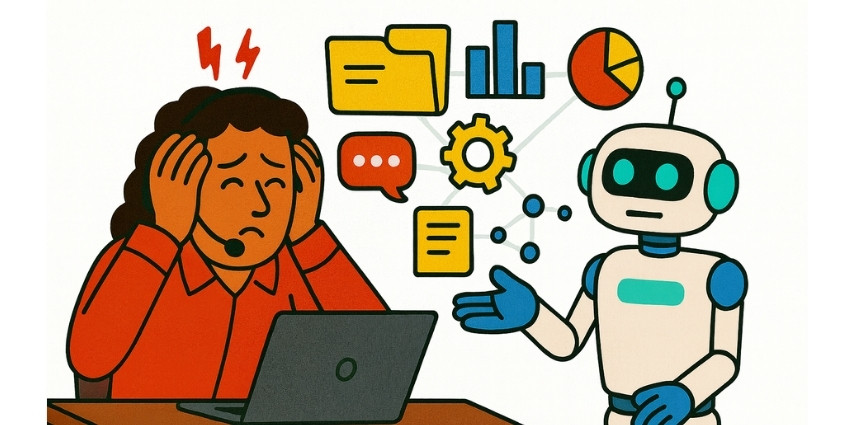The contact center is at the heart of the customer experience toolkit. But legacy contact centers weren’t designed to handle today’s reality. They weren’t made for distributed teams, or AI routing, or customers switching channels halfway through an interaction. What they were built for was volume, and volume alone isn’t enough anymore.
Contact Center as a Service (CCaaS) offers an architecture that aligns with how modern businesses work. Every channel, voice, messaging, chat, social, is handled in one cloud-based system. All your agents see the same data. Every update goes live without a maintenance window.
CCaaS is the future of operational alignment. One platform that routes conversations, analyzes performance, integrates with CRM, and adapts fast when volumes spike or teams go remote.
The growth reflects that shift. Enterprise adoption of CCaaS solutions has outpaced small business adoption since mid-2023, according to Metrigy and Omdia. By 2032, the market will be worth over $24.45 billion. So, what is CCaaS exactly, and where is it headed?
What is CCaaS? Contact Center as a Service
CCaaS stands for Contact Center as a Service. It’s a cloud-based model that replaces on-premises infrastructure with a software platform hosted and maintained by the provider. Routing, IVR, call recording, analytics, workforce scheduling, all delivered through the browser.
The core value isn’t just infrastructure offloading. It’s adaptability. A change in call flows doesn’t need six weeks of engineering. A surge in Spanish-language support doesn’t require hiring locally. Features ship faster. Agents onboard faster. The system stays current without downtime.
Legacy platforms struggle with this kind of elasticity. They were built for physical sites, not global queues. They assume control rooms, not home offices. For enterprises with thousands of agents spread across time zones, the friction adds up fast.
Modern CCaaS platforms are designed to eliminate that friction. They support omnichannel interactions, allow dynamic routing based on skills or sentiment, and integrate directly with CRMs, CDP systems, Workforce management tools and more.
Many include conversational AI as standard, with agent-assist overlays, self-service solutions and automated compliance logging built in. Ultimately, CCaaS leaves the expense and complexity of the on-premises contact center behind in favor of flexibility.
What is CCaaS? Call Center vs Contact Center vs CCaaS
The terms still get used interchangeably, but the operational differences matter.
Traditional call centers are voice-first environments. Designed around high call volumes, they rely on phone queues, fixed infrastructure, and human agents working from centralized locations. Routing logic tends to be static. Reporting is retrospective. Integration with CRM or business systems is often limited, if it exists at all.
Contact centers expanded that model. They introduced email, chat, and digital channels, giving customers more ways to reach support. But for many enterprises, those channels still run in silos. Voice lives on one system, messaging on another. Agent views vary by team. Data is split across applications and requires manual reconciliation.
Contact Center as a Service (CCaaS) solves this by unifying all customer interactions in a single cloud-native environment. Voice, chat, email, and SMS share one queueing engine. Agents switch between channels without losing context. Supervisors view real-time performance across all touchpoints, not just one.
The shift isn’t just about channel diversity, it’s about architecture. CCaaS platforms are designed for integration. CRM sync isn’t an add-on. Workforce engagement tools aren’t bolted on after deployment. Everything lives in the same ecosystem, so escalation, forecasting, and reporting happen in real time and in one place.
That’s where most enterprise teams now draw the line. A call center is a volume handler. A contact center adds options. A CCaaS platform connects the entire experience, technically and operationally.
UCaaS vs CCaaS vs CPaaS
Too many enterprise communication stacks still operate in fragments. Internal conversations happen in one system. Customer service lives in another. Developer-built workflows hang off a third set of APIs. These gaps are expensive to maintain and harder to secure.
Unified Communications as a Service (UCaaS) handles voice, video, messaging, and meetings between employees. Contact Center as a Service (CCaaS) supports external communication, customers calling, chatting, emailing, or texting. Communications Platform as a Service (CPaaS) is the custom layer that connects these systems into apps, automations, or alerts.
In practice, these models aren’t neatly separated. Customers switch channels midstream. Internal teams step into active support threads. Marketing needs visibility into service conversations. Engineering needs to trigger communications based on events. The split between UCaaS, CCaaS, and CPaaS is structural. The reality is blended.
That’s why platform convergence is now a buying priority. Not just for operational simplicity, but for visibility, security, and consistency. When all communication lives in one ecosystem, context doesn’t get dropped. Data doesn’t get duplicated. No one has to rebuild workflows that should already be native.
Vendors have moved to reflect this shift. Many CCaaS providers now offer UCaaS as part of the same platform, or embed UC tools directly into agent desktops. Others integrate CPaaS capabilities to allow for programmable routing, two-way messaging, or event-based triggers across business systems.
What is CCaaS? Key Features of CCaaS Platforms
In high-volume environments, gaps show quickly. One system manages calls. Another handles chat. CRM data pulls from a third source. Analytics lag. Agents switch tabs. Supervisors lose visibility. Over time, these points of friction harden into cost.
Modern CCaaS platforms are designed to remove that complexity. Every core function, channel management, agent workflow, routing logic, real-time data, is built into the same environment.
While the features of CCaaS solutions vary, most include:
Omnichannel Routing and Queue Management
Every channel flows through a unified routing engine. Voice, chat, email, SMS, and social are all managed in the same queue. Customers reach the right agent based on language, region, history, or sentiment. Escalation paths aren’t manual; they’re baked into the logic.
The benefit is continuity. Customers don’t have to start over when switching from chat to voice. Agents don’t waste time reconstructing context. Supervisors see one live view across all queues, not five dashboards stitched together. Plus, CRM solutions ensure context is retained, and aligned, making the customer journey more consistent.
Interactive Voice Response (IVR) and AI-Enhanced Routing
Callers expect more than a numbered menu. CCaaS solutions support dynamic IVR flows that adjust based on inputs, history, or account data. Many include conversational AI that can capture intent in natural language, triage common issues, and hand off to agents when needed.
This isn’t just about deflection. It’s about routing based on relevance, matching customers with the agents best equipped to help, not just the next one available.
CRM, CDP, and ERP Integration
Agent efficiency depends on visibility. The best CCaaS providers integrate directly with customer systems, CRM platforms like Salesforce or HubSpot, customer data platforms, ERP systems, or internal knowledge bases.
Instead of copying and pasting between windows, agents see contact history, open cases, customer preferences, and product usage at a glance. Some platforms offer bi-directional sync, allowing updates made during the interaction to write back into CRM in real time.
The rise of APIs ensures that companies can combine their contact center with anything, from back-end collaboration tools that allow employees to work together to solve consumer problems to chatbots and predictive analytics.
Workforce Engagement Tools
Managing performance at scale requires more than raw metrics. Top CCaaS solutions include built-in workforce engagement features: forecasting, scheduling, shift swaps, coaching, quality monitoring, and performance alerts, all in the same platform.
When these tools are part of the same environment, supervisors don’t waste time importing data or reconciling agent reports. Feedback happens in context. Coaching is immediate. Visibility is complete.
Real-Time Analytics and BI Dashboards
Metrics are only useful if they’re current. Legacy platforms often report with delay. Modern CCaaS technology updates in real time. Supervisors can see call volume spikes as they happen. CX leaders can compare regional performance, identify bottlenecks, and adjust in minutes.
Dashboards show queue health, agent status, interaction outcomes, and sentiment across channels. Some offer custom drill-downs for deeper business intelligence. Reporting is also directly tied to routing, workforce performance, and customer behavior. Some vendors are even offering in-depth conversational analytics tools to track intent, sentiment, and engagement levels.
Security, Compliance, and Local Governance
Handling sensitive data at scale means compliance isn’t optional. Enterprise CCaaS platforms need to meet standards like PCI-DSS, GDPR, HIPAA, and local data residency laws. Encryption, audit logs, and role-based access are the baseline. Leading vendors also support redaction, regional routing controls, and identity integration through SSO or Active Directory.
Many solutions also support add-on security solutions, designed for specific governance needs, handling AI compliance, and tackling data privacy at scale.
Integrated Collaboration Tools
Teams work better when they’re connected. The rise of CCaaS connected with UCaaS gives distributed, in-house agents access to consistent, collaborative, intelligent, and omnichannel technology. This connection leads to faster, improved service from agents, who always have access to the colleagues and support they need.
It also helps to reduce inefficiencies, improve data insights (by aligning information throughout the business), and keep teams engaged, reducing turnover.
Artificial Intelligence
AI isn’t an add-on anymore, it’s everywhere. Generative AI bots are supporting agents by helping them to answer questions faster with tailored responses. Conversational AI solutions are handling self-service tasks. Even agentic AI systems are quickly finding their place in marketing, sales, and customer service workflows.
AI is capturing customer data, automating tasks, and streamlining workflows faster than ever before. It’s also helping businesses to scale, into new regions, new channels, and new opportunities, without the need for excessive extra headcount.
What is CCaaS? The Core Benefits for Enterprise Teams
The argument for Contact Center as a Service starts with consolidation. But the real value emerges after deployment, when the platform starts making things easier, faster, and more precise.
Reduced Costs
Traditional platforms are cost heavy. Licensing, hardware, maintenance contracts, IT support. Then there’s downtime to consider too – something 33% of enterprises say costs them $1-5 million per hour. CCaaS solutions strip out that weight. Infrastructure lives in the cloud.
Software updates don’t need approval cycles. Capacity adjusts without new hardware. Pricing scales with usage, not headcount. More importantly, the platform becomes predictable. Enterprise-grade CCaaS platforms are built with redundancy, geographic failover, and compliance by default. Interruptions are rare. When they happen, service reroutes automatically.
Configuration happens in real time.
Routing doesn’t need to go through IT. New channels don’t take six weeks. Most platforms give supervisors access to flows, queues, and logic from inside the interface. That changes how teams respond. Outage? Spin up a dedicated support line. High-value segment? Route them to a separate pool. Volume spike in a specific language? Prioritize agents with matching skills.
The difference with CCaaS technology is how much gets handled without external support. Fewer dependencies. Fewer blockers. The contact center becomes more self-sufficient.
Agents get better tools, not just more of them
Multiple tabs, logins, and systems that don’t talk to each other. That’s still how many agents work today. With CCaaS technology, that gets replaced by one interface. Conversations, history, sentiment, and next steps, all visible in context.
Some platforms go further. AI agent assist tools can surface relevant knowledge or summarize a prior interaction while the agent is on the call. It’s not magic. It’s just useful.
Customers experience improves
Repeating the issue. Explaining it again. Switching channels and losing context. Those are signs of a system problem, not a customer problem.
CCaaS providers route interactions based on more than queue length. Data from past interactions, customer type, or channel preference can drive decisions before the agent picks up. When escalation happens, history follows. Even if the agent is new to the case, they’re not new to the customer.
The contact center scales
Enterprise teams stretch across time zones, continents, and compliance zones. Running voice through an on-premise system makes less sense every year.
Cloud-native CCaaS platforms support region-specific routing, distributed agent pools, and localization at the infrastructure level. Volume can shift. Teams can flex. Coverage windows expand easily. There’s also less pressure to run overnight shifts or duplicate roles across sites. One system and multiple time zones are all aligned.
Reporting is faster and closer to the truth
Most enterprise systems show what happened yesterday. Rarely what’s happening now. Modern CCaaS solutions track queue performance, agent status, sentiment scores, and interaction outcomes in real time. Dashboards reflect what’s happening across channels, not just voice. Leadership doesn’t need to ask for reports. They already have them.
That improves staffing, forecasting, and decision-making. But more importantly, it helps teams correct course before small issues grow.
Challenges and Considerations with CCaaS Solutions
CCaaS platforms solve a lot of problems, but they also introduce new ones. For enterprise buyers, the complexity doesn’t disappear. It just moves. Common issues include:
- Integration snags: Most contact centers rely on a web of systems. CRM. ERP. CDP. Helpdesk. Knowledge base. Security layers. Getting all of them to sync with a new platform takes planning, and not every CCaaS provider plays well with legacy architecture. APIs exist, but mapping workflows takes time. Working with an expert can help here.
- Data residency and compliance take priority: Handling customer data in multiple jurisdictions comes with rules. Some platforms offer regional hosting. Others don’t. Some can isolate traffic or restrict access by geography. Others rely on global instances and add encryption on top. Plan your strategy for compliance before rollout.
- Change management can stall progress: Contact centers are tightly wound environments. Change introduces uncertainty. New platforms impact scripts, workflows, training materials, and team culture. Without the right development strategy even a better system can create friction.
What’s Next for CCaaS?
The core capabilities of CCaaS platforms, routing, queueing, reporting, aren’t changing. What’s changing is the environment they operate in. More channels, more customer data and a lot more pressure to do things faster, more accurately, and with less human effort.
The most competitive platforms are responding with structural upgrades, not just feature releases. Here’s where the movement is heading.
AI Everywhere
Agent assist is no longer the future. It’s embedded. The best CCaaS providers now offer in-call summarization, knowledge retrieval, and response suggestions in real time. These tools reduce cognitive load and support consistency across large teams.
On the customer side, AI is improving the quality of self-service. Natural language understanding makes IVR less rigid. Multilingual bots handle low-complexity queries with higher resolution rates. The gap between automation and live support is shrinking. Agentic AI is making waves too, with systems that can connect to multiple apps and complete entire workflows autonomously.
Channel orchestration
Omnichannel used to mean offering more channels. Now it means understanding how customers move between them, and guiding that flow based on context.
Modern CCaaS solutions support orchestration across voice, chat, email, and messaging. A customer might begin in chat, escalate to voice, and receive a follow-up via SMS, all within the same ticket. Routing rules are tied to behavior, not just queues.
Continued Convergence
The line between CCaaS, UCaaS, and CPaaS is disappearing. Buyers don’t want voice in one system, internal messaging in another, and customer notifications handled through custom scripts.
Vendors are responding by bundling, or at least natively integrating, these functions. One admin interface. One data model. One reporting engine. The result is lower cost, tighter security, and fewer configuration gaps.
Metrics are moving from reporting to recommendation
Raw data is easy to collect. Turning it into action is harder. The most advanced CCaaS technology is starting to bridge that gap with predictive insights, flagging capacity issues before they spike, highlighting performance anomalies, or recommending schedule changes based on historical trends.
Instead of generating dashboards for review, platforms now prompt supervisors with suggestions. These prompts don’t replace judgment but they reduce uncertainty.
AI compliance is becoming a selection filter
As AI expands across the contact center, the way it’s governed matters. Enterprises are asking tougher questions. Can automated decisions be explained? Can transcripts be redacted? Does the platform support region-specific AI policies?
Some CCaaS providers have built frameworks to address this head-on. Others haven’t caught up. In 2025, that delta is influencing procurement, not just in regulated sectors, but in any organization operating at scale.
What to Look for in a CCaaS Provider
Some CCaaS platforms check boxes. Others solve problems. The difference usually shows up a few weeks after go-live, when the volumes kick in, the systems connect, and the edge cases stop being theoretical. Here’s how teams can compare CCaaS platforms:
- Reliable infrastructure: Platforms need to be designed for peak hours, global teams, and unpredictable contact volumes. Look for built-in redundancy, distributed hosting, real-time failover, and impressive SLAs.
- Easy integration: CCaaS solutions should fit cleanly into CRM, CDP, ERP, and IAM systems, without creating new connection points to manage. If CRM data can’t be pulled into the call flow, or if WEM tools don’t sync agent metrics, the platform adds friction instead of removing it.
- Ease of Use: Queue logic, routing rules, opening hours, language preferences, all of these things shouldn’t need IT support to step-in. Supervisors should be able to adjust workflows directly, from inside the platform.
- Extensive reporting: Dashboards built for weekly reviews don’t help in live environments. The best CCaaS providers give supervisors real-time visibility into queue status, agent activity, and customer sentiment across all channels.
- A roadmap: The product strategy should be visible. If AI features are in beta, when will they launch? If integrations are limited today, which ones are next? If compliance is a concern, what regions are supported, and how?
Want to check out the top CCaaS providers in the market today? Visit our market map.
Implementing CCaaS: Best Practices
The most common question after “What is CCaaS” is “How do we implement it correctly?” Rolling out a CCaaS platform takes focus. The technical lift is only part of the process. Without the right operational structure around it, even the best deployment won’t reach its full value.
1. Define what success looks like up front
Volume alone isn’t the right metric. Start with a clear goal: reduce transfer rates, increase first-contact resolution, improve agent retention, shorten onboarding. Each of these outcomes has different implications for configuration, staffing, and training.
Most teams aim for too much at once. The better approach is narrower: pick two or three metrics that matter, build around those, and expand from there.
2. Start small, but not too small
A pilot environment helps. It catches edge cases and builds confidence across teams. But a test group of five agents working a single queue won’t tell you how the platform performs under load.
The best pilots reflect real-world conditions: blended channels, rotating shifts, multilingual routing, live escalation paths. The goal isn’t a smooth demo. It’s useful data.
3. Sequence integrations, don’t stack them
Trying to connect CRM, ERP, WEM, and analytics systems on day one guarantees delays. Phase the rollout. Start with what agents need to do their jobs. Then layer in visibility tools for supervisors, then automation, then advanced routing or reporting.
Stacking everything at once creates noise. Building in sequence creates clarity.
4. Treat routing as a living system
Customer behavior changes. So do product lines, SLAs, and channel preferences. A static routing plan will fall behind. The routing logic needs to be reviewed regularly, weekly in the early months, then monthly as patterns stabilize.
Some CCaaS platforms offer routing heatmaps or performance alerts to surface inefficiencies. If those tools exist, use them. If not, create a cadence anyway.
5. Train everyone
The people running the queues should own the flows, the reports, and the dashboards. That means training that goes deeper than button clicks.
Focus on process logic. What happens if volume doubles? If an agent drops mid-escalation? If sentiment flips on a customer with open cases?
What is CCaaS? The Future of Contact Centers
The value of Contact Center as a Service doesn’t come from any single feature. It comes from what the platform enables: faster decisions, cleaner workflows, and systems that move as quickly as the customers they support.
The strongest CCaaS solutions make everyday tasks easier, reduce technical sprawl and centralize logic, reporting, and routing into a single place where teams can work with confidence.
Choosing the right provider starts with clarity. Not just on features, but on fit, how the system handles complexity, how it integrates, how it adapts when conditions change. The difference between a good platform and the right one usually shows up six months into deployment.
Still need help? Dive into our exclusive resources:
- Connect with the CX Today Community: Stay ahead of CX, AI, and contact center trends through expert insights and peer discussions.
- Explore the Ecosystem: Use our market maps to learn more about the top CX vendors leading the way today.
- Download the Research: Access exclusive research reports covering everything enterprises need to know about contact center opportunities.
- Test the technology: Meet contact center leads at the latest upcoming events, and put the systems to the test.
Or head straight to the full breakdown of today’s most impactful CX technologies.
No platform will remove complexity from the contact center entirely. But the right one can keep it manageable. For buyers leading that shift, the decision isn’t just about replacing legacy tools. It’s about building a foundation that scales.







